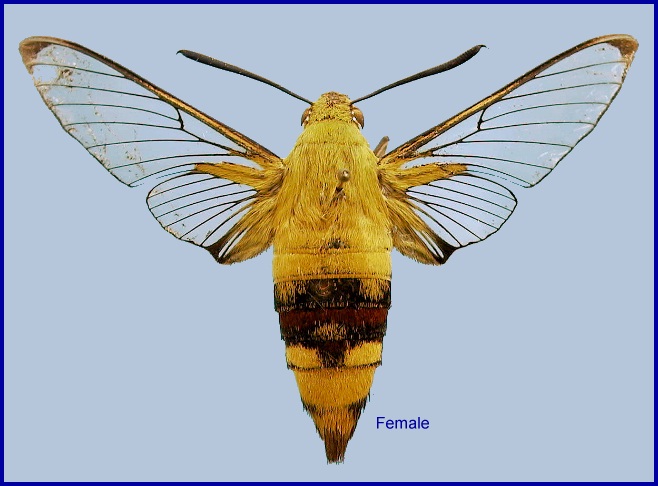
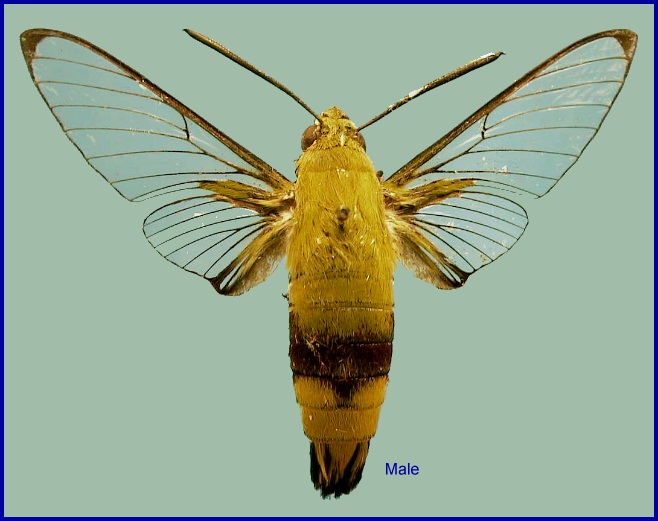
Sphinx hylas Linnaeus, 1771, Mant. Plant. Alt.: 539. Type locality: China.
Synonym. Sphinx hylas Linnaeus, 1771.
Synonym. Hemaris hylas (Linnaeus, 1771).
[Further details on this species in Japan, as well as photos of many stages, can be found on Digital Moths of Japan as well as Moths of the southern Shikoku, Japan.]
Wingspan: 45--73mm. Upperside of abdomen with a black and dark red belt; tergite 6 with a black median patch, which often has some red scales; anal tuft green. Foretibia lacking a pronounced apical claw. Underside of head, thorax white or slightly yellowish (but never orange as in Cephonodes picus); abdominal tuft black. When the moth first emerges, which it usually does in the early morning, the hyaline portion of the wings is covered densely with greyish scales. These come off in a little cloud when the wings are rapidly vibrated before the first flight (Bell & Scott, 1937).
Male genitalia strongly asymmetrical. Uncus twisted, apex directed to right; left lobe reduced to a plate visible in ventral or lateral view from the left; right lobe strongly developed, forming a long, obtusely pointed hook, concave dorsally and strongly expanded anterior to the apical hook. Gnathos without processes, represented by a low rounded ridge. Apex of juxta with sparse, short hairs. Distal margin of left valve strongly concave; dorsal lobe broad and flat, outer margin covered in minute, peg-like setae; ventral lobe much shorter than dorsal lobe or absent, inner surface lacking long, upwardly directed setae. Inner face of right valve with a poorly developed median longitudinal groove, lacking inwardly directed hairs, the ventral margin of which is produced dorsally as a low fold.
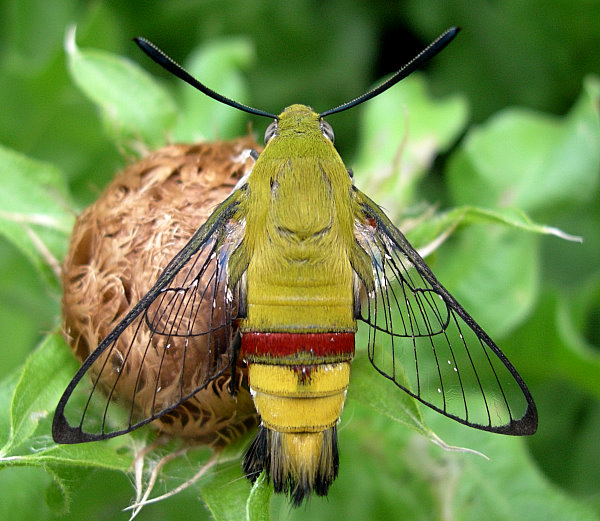
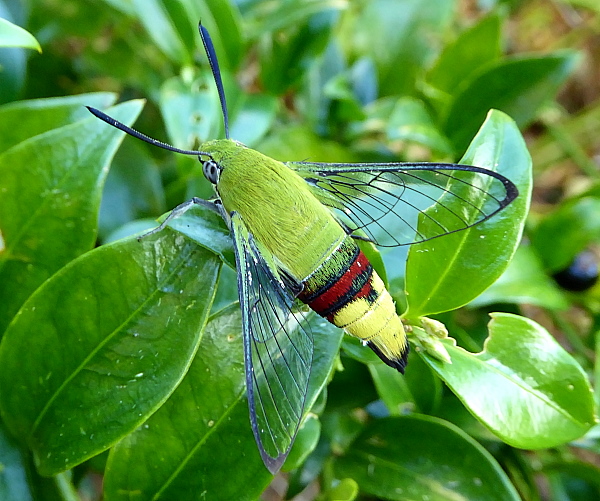
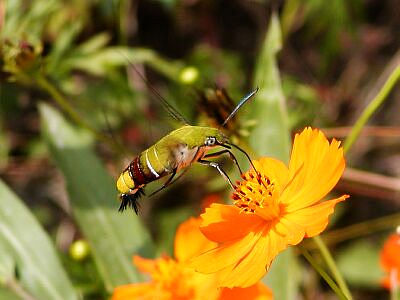
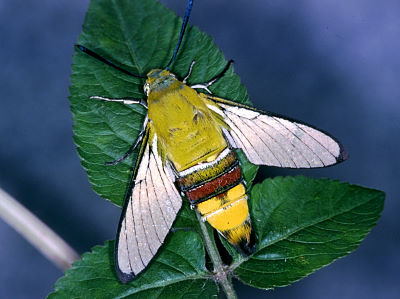
A day-flying moth attracted to the flowers of Duranta erecta in Hong Kong. Common in urban parks and gardens where Gardenia is grown.
The moths are rather slow in taking to the wing, but when they do so the flight is very rapid. They make a deep humming note when slightly alarmed, as do Macroglossum moths. They are very active in the morning and evening and dart rapidly from flower to flower, as well as ovipositing on the wing. They are not attracted by light. Bred females do not readily attract wild males, but the sexes pair freely in captivity (Bell & Scott, 1937).
China: iii-v (Hong Kong); v-vii (Hainan); vi (Sichuan); vi (Guangdong); vii (Jiangsu; Zhejiang; Hong Kong); viii (Guangdong); 5-18.ix (Hong Kong); 15.xi (Hong Kong); xii (Hong Kong). Taiwan: iv-vii (Hualien Hsien). Japan: 17.iii (Ryukyu Archipelago); 17.iv-vii (Kyushu); 26.iv (Ryukyu Archipelago); 21.v (Shikoku); vi-vii (Honshu); 12.vii (Kyushu); vii-viii (Ryukyu Archipelago); 7.viii (Hokkaido); 24.viii-17.x (Honshu); ix-x (Ryukyu Archipelago).
Park et al. (1999) give early July until late September as the flight period in Korea.
OVUM: Pale blue-green or grass-green when freshly laid, becoming pale canary yellow with age. Oval (0.75 x 0.85mm), shiny and very smooth. Laid singly or in pairs on the underside/uppserside of young leaves near the growing tip, or on shoot tips.
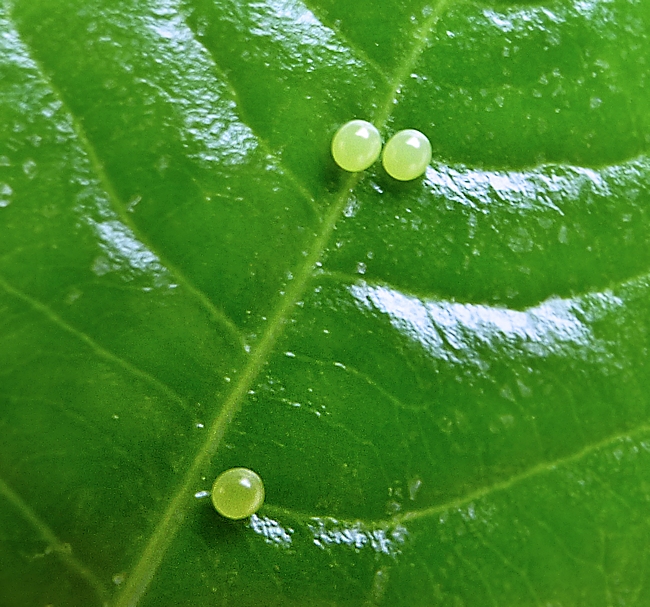
LARVA: Full fed 55--65mm. Polychromatic, but mainly green or brownish-black. [A plate from Butler (1876)]
In the first instar, head round; body cylindrical; horn long, straight, bluntly bifid. Head covered with hairs 0.15mm. long, shortly bifid, the branches 0.01mm. long. Body covered with bifid hairs, stem and branches both 0.05mm. Horn shiny and covered densely with bifid hairs. Head and body pale yellow; horn black with some red at the base. In the second instar, similar to first instar but segment 2 yellow, rest of body green with black, transverse lines, or smoky-black. In the third instar, head and a shield on segment 2 orange, rest of body as above or oily-looking black. In the fourth instar, segment 2 of greater diameter than head or segment 3, the saddle-shaped shield raised above the surface of the segment. Horn very long, straight, sharply pointed. Surface of head, shield, horn, anal flap and claspers tuberculate; the hairs of the first instar still present but proportionally much shorter. Head dark green, segment 2 green, the shield darker green with yellow tubercles; the remaining segments yellowish-green. There is a broad, dark brown dorsal stripe, a white dorso-lateral stripe, and a black pear-shaped spot below it on 3 to 12. A narrow, black band runs along the margins of these segments, and the is an oval lateral black spot on 12. Horn black; legs and prolegs dark red; anal flap and claspers dark green with paler tubercles; spiracles dark yellow (Bell & Scott, 1937).
In the dark-coloured form the head, the anal flap and claspers greenish-ochreous; shield the same, with yellow tubercles. Body oily-looking black with a broad, velvet black dorso-lateral stripe.
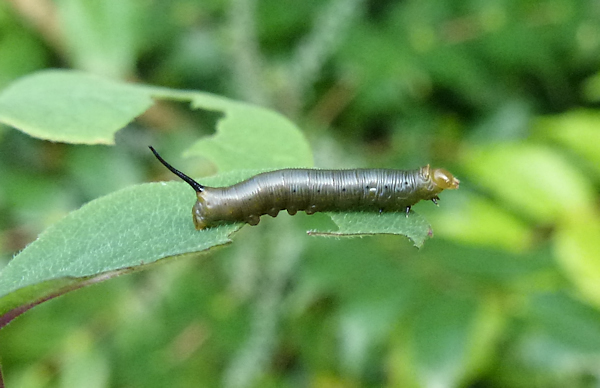
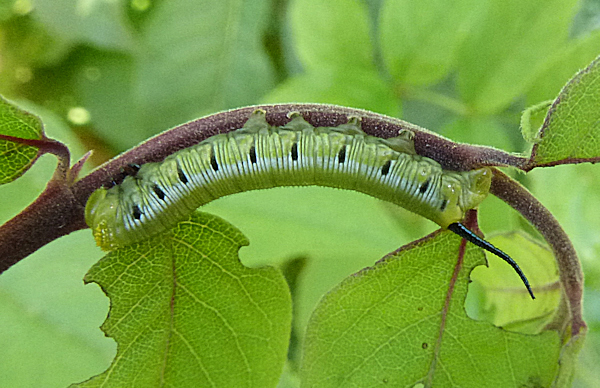
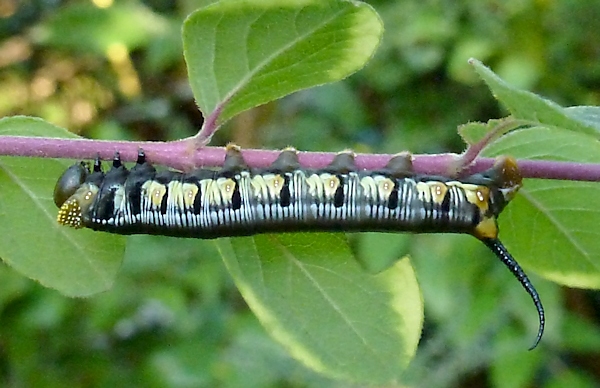
In the final instar, head round. True clypeus less than half length of head, apex acute, sides slightly concave; false clypeus with apex broadly rounded, sides angled slightly outwards; labrum half length of clypeus and as broad as clypeus, narrowing slightly frontad, sides convex; ligula slightly longer than labrum, kidney-shaped. Surface of head dull, covered with small, low, glassy tubercles. Body tapering gently from segment 7 frontad and posteriad to 12, segment 2 of greater diameter than head, and with a raised shield covering most of the upper half of the segment. Horn long, down curved, stout at base and tapering evenly to a sharp point, rising from a conical tumidity. Surface of body smooth and shiny; shield on 2 set closely with low, shiny tubercles. Horn polished, set with small dark tubercles; clasper-faces with similar tubercles to the shield; the supra- and subspiracular hairs visible.
Coloration very variable. In the green form (see below), head and tubercles glaucous-green, labrum and ligula the same. Basal segment of antenna glassy-green, second segment reddish, third pink; mandible green, with the tip broadly reddish-brown. Body glaucous-green above the subdorsal stripe, grass-green below it. Shield of segment 2 green, with yellow tubercles. There is an ill-defined purplish dorsal stripe from segment 3 to base of horn. There is also a sharply defined subdorsal stripe, which is white on 3 to 11, yellow on 12, where it becomes broader and curves upwards to base of horn; this stripe edged very narrowly above with pink on 10 and 11. Just below it there may be a black comma or inverted pear-shaped patch, which may be continued as a narrow band to below the spiracle. There is also an irregular-shaped purple patch from above the spiracle of 12 to point of clasper. Sometimes a white subspiracular stripe edged above with black may be present in the middle of each segment, on segments 6 to 10, and black dots where the white subdorsal stripe crosses the junctions of the secondary rings; venter purple. Horn yellowish-green, tip black, tubercles on upper surface black, on under surface yellowish-green. True legs pink; prolegs with bases dark purple, shanks pink. Spiracles oval, flush, pure white with a broad orange band across middle, the whole with a green or orange rim.
In the dark-coloured form, head brown or pale orange; segment 2, anal flap and claspers ochreous-orange; rest of body smoky-black. There is a sharply defined dorsal stripe, black or bluish; subdorsal stripe white or pink, with a broad black stripe below it and narrow black bands along the margins of the secondary rings. Horn black; spiracles lying on oval orange patches (Bell & Scott, 1937).
The larvae are sluggish but eat very greedily and continuously. When molested they sometimes throw the head back over the dorsum until the mouth-parts are directed upwards and eject green fluid from the mouth. The body becomes suffused with brown before pupation.
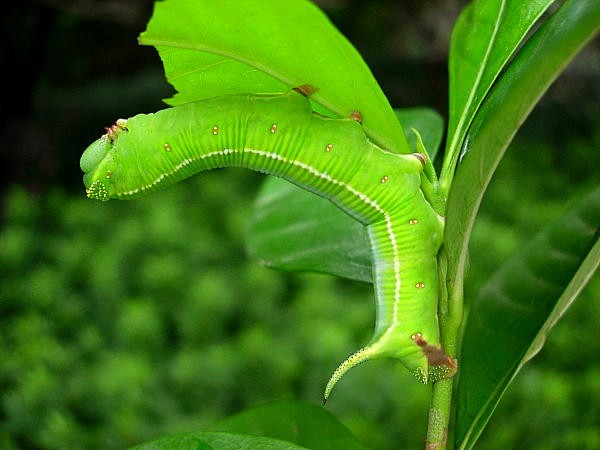
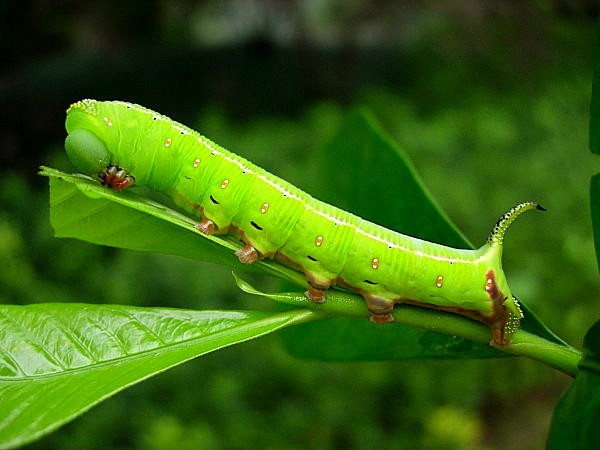
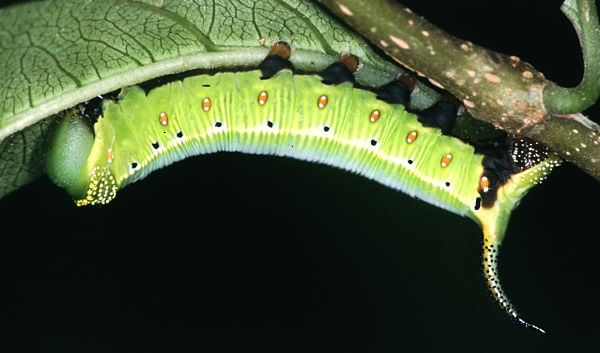
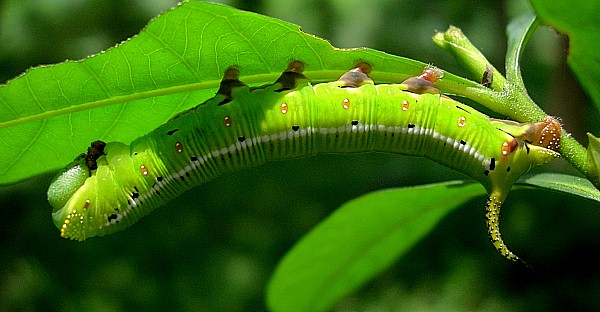
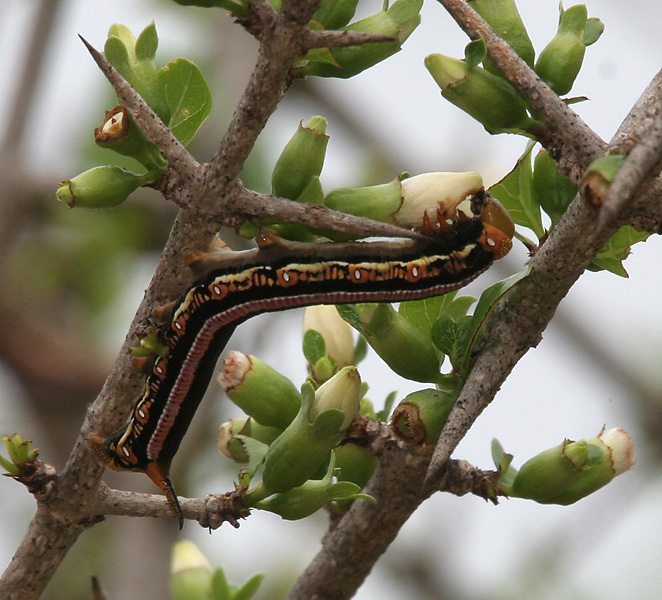
PUPA: 27--35mm.; breadth 10mm. Colour dark brown, the bevels of the free abdominal segments red-brown, spiracles dark brown and cremaster black. Head proximally round, distally conical. Segments increase gradually in diameter from head to middle of pupa then decrease more rapidly. Dorsal line slightly convex, ventral line nearly straight; frons at right angles to longitudinal axis; a small tumidity at the point where eye, tongue and frons meet. Surface shiny, wing-cases nearly smooth, rest of surface covered with deep coalescing pits, strongest on 2 and on the abdomen. Segment 4 with sculpturing consisting of a median, transverse, raised band, interrupted at the dorsal line and extending downwards to lateral area. There are several narrow, irregular, ante-spiracular ridges on 9, with pitting between them; and similar but less strong ridges on 10 and 11. Spiracle of 2 a narrow slit situated between the slightly raised hind margin of 2 and a long straight lobe on front margin of 3. Remaining spiracles extremely narrow ovals, with narrow, raised edges. Cremaster rugose, broadly conical but dorso-ventrally flattened, terminating in a thin, polished tapering point with a minutely bifid tip (Bell & Scott, 1937).
Pupation takes place in a rough cocoon on the surface of the ground amongst the foliage of the hostplant, or more rarely just under the surface of the earth. It is formed of leaves, earth particles etc., held together by a few strands of silk. The pupa is not attached to the inside of the cocoon.
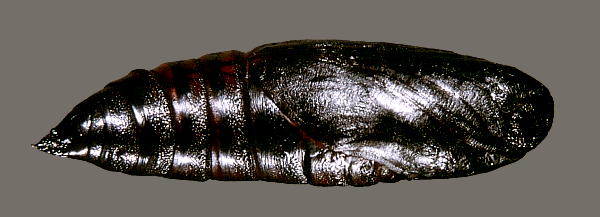
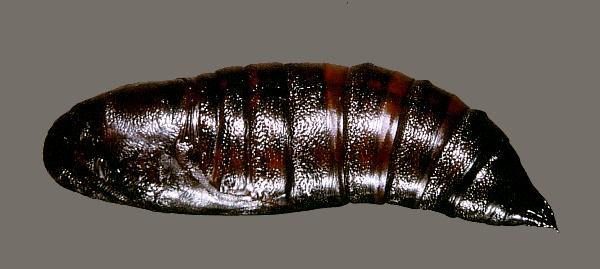
Larval hostplants. Recorded from Gardenia jasminoides in Korea (Park et al., 1999), and coffee (Coffea spp.) in Yunnan, China. In Hong Kong, Gardenia jasminoides, Catunaregam spinosa, Pavetta hongkongensis and Tarenna attenuata are the preferred hosts (David L. Mohn, pers. comm. 2002).
Common on ornamental Gardenia jasminoides in the public parks of Hangzhou, Zhejiang (Pittaway, pers. obs. 2004). During the very hot summer months, plants growing in deep shade are preferred.
In Taiwan, recorded from Cinchona calisaya [syn. Cinchona ledgeriana], Diplospora dubia [syn. Tricalysia dubia], Ficus subpisocarpa, Gardenia jasminoides, Guettarda speciosa, Ixora philippinensis, Mussaenda pubescens, Wendlandia formosana and Wendlandia uvariifolia.
Elsewhere also from Adina (such as Adina pilulifera and Adina rubella), Haldina, Mitragyna, Mussaenda, Randia, Catunaregam, Wendlandia, Ixora, Pavetta and Hymenodictyon (Inoue, Kennett & Kitching, [1996] 1997).
[Easily reared in captivity on potted Gardenia plants and the hardy North American Cephalanthus occidentalis. It will also accept most species of Lonicera and Symphoricarpos (Hayashi, 2006; Serge Yevdoshenko/Tony Pittaway, pers. obs. 2015), and has been reared on Scabiosa (Serge Yevdoshenko, pers. obs. 2015). In the milder parts of Europe this species can be reared indoors during the winter months on the evergreen Lonicera japonica and Lonicera nitida (young shoots). Hayashi (2006) reared it on Lonicera sempervirens and Lonicera japonica.]
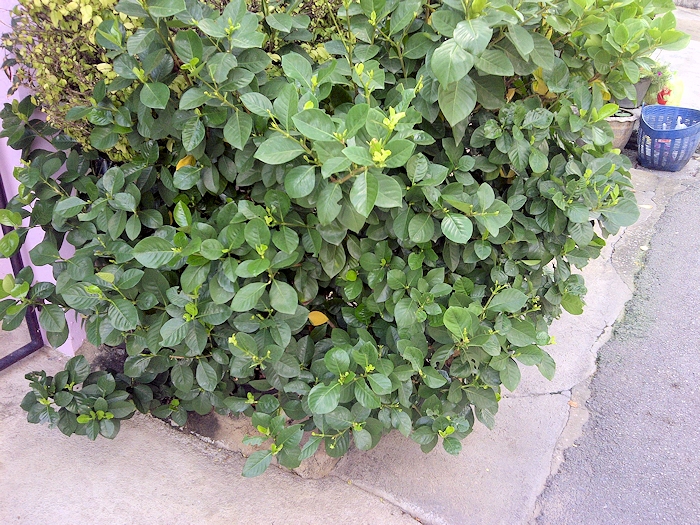
Encyrtidae: Ooencyrtus papilionis Ashmead, 1905; Tachinidae: Blepharipa zebina (Walker, 1849).
China: Beijing; Jiangsu (Longtan); Anhui (Mt. Huang Shan; Hefei); Shanghai (Baoshan); Zhejiang (Mogan Shan; Tianmu Shan; Hangzhou); Sichuan (Baoxing; Kangding); Chongqing (Chongqing); Yunnan (Yanmen; Gaoligong Shan); south Xizang/Tibet (Nyalam, 2250m); Hunan (Changsha); Jiangxi (Tiancun, nr. Xingguo); Fujian (Fuzhou); Guangdong (Guangzhou; Fengwan; Dongguan); Macau; Hong Kong (Kowloon; North Point; Chung Hom Kok); Guangxi; Hainan (Chengmai; ??Mangrin; ??Secha).
Taiwan: Hualien Hsien (Taroko National Park); Nantou Hsien (Puli); Kaohsiung Hsien (Shanping, 640m); Chiayi Hsien (Shuicheliao); Tainan; Taipei; Taipei Hsien (Fushan).
South Korea: South Cholla Province (Jin-do); South Kyongsang Province (Masan; Geoje-do; Goseong; Namhae; Jinju; Hadong); Cheju Province (Cheju-do; Biyang-do; Ara-dong; Topyung; Sinsan; Cheonjiyun).
Japan: Hokkaido; Honshu (Nagasaki; Oshima Island in Sagami Bay; Yokohama; Gifu; Shinshiro; Fujisawa; Kugenuma; Bushi); Shikoku (Kochi); Kyushu (Kagoshima; Chiran; Ishiyara; Shimoyakumura); Ryukyu Archipelago (Amamio-jima; Okinawa, Nago; Okinawa, Yonabaru; Okinawa, Shuri; Okinawa, Nakijin; Ishigaki-jima; Iriomote-jima; Torogawa; Yaku-jima; Yonaguni-jima (Kishida & Shirakawa, 1988)).
Russia: Primorskiy Krai (Vladivostok) (Efetov, 1986).
Cephonodes hylas hylas is widely distributed in Asia, from northern Pakistan (Rafi et al., 2014), India (Pathania, Sunita Sharma & Gill, 2014; Subhasish Arandhara, 2017), Nepal, Bhutan (Irungbam & Irungbam, 2019) and Sri Lanka, east through Burma/Myanmar and China, to South Korea and southern Japan, then south and east through Thailand, Laos, Vietnam, Taiwan, Peninsular Malaysia, the Philippines (Inoue, 1996) and Indonesia as far as Borneo and Java. The single record from the southern Russian Far East is of a vagrant (Efetov, 1986).
[It is replaced by other subspecies in the eastern Lesser Sunda Islands, Australia and Africa.]
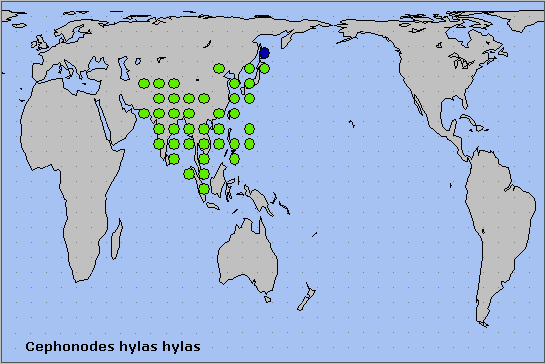
 Return to Sphingidae of the Eastern Palaearctic species list
Return to Sphingidae of the Eastern Palaearctic species list